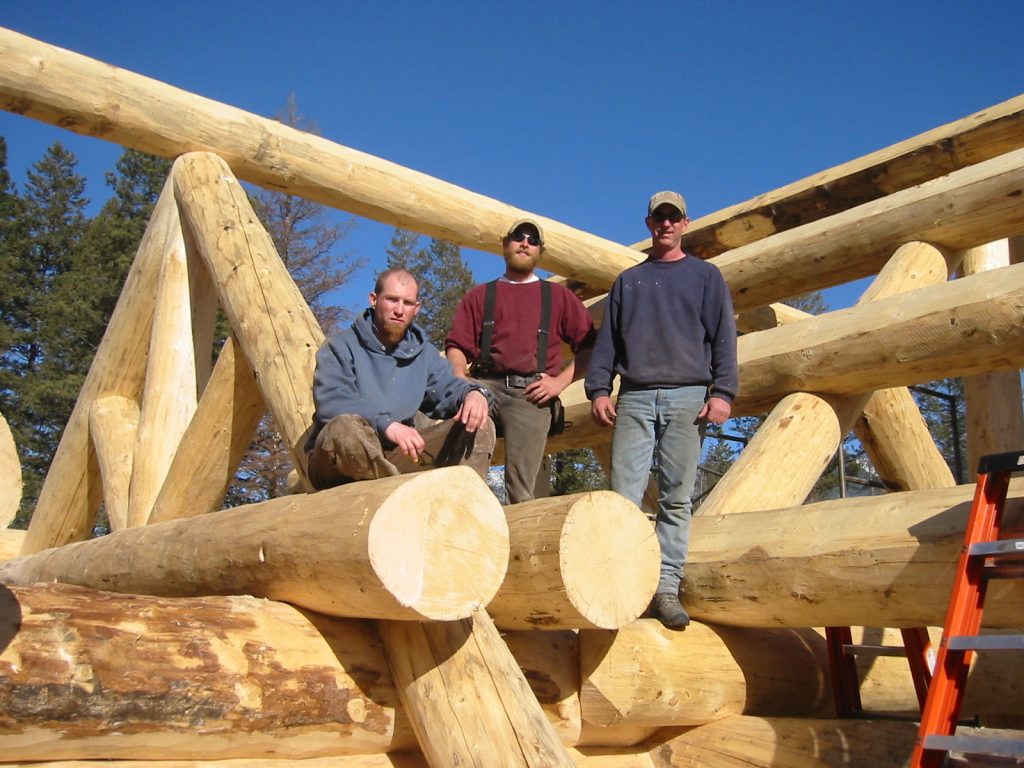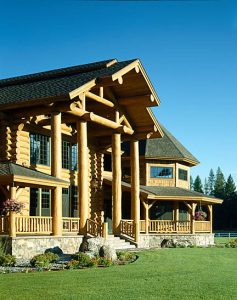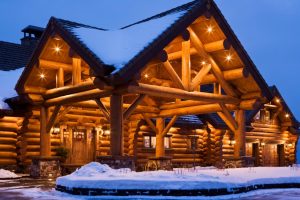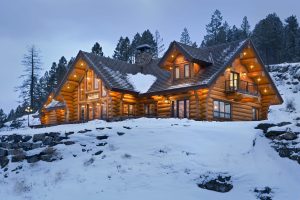Using Engleman Spruce for a Handcrafted Log Structure

Old Style Log Works Crew building a roof system with Engleman Spruce
The next species to discuss on our list for full log construction is Engleman Spruce. Like Lodge Pole Pine and Western Larch this species exhibits the qualities of tall, straight and minimal taper. This makes Spruce an option for log building especially if its limitations (i.e. low decay resistance) is factored into the design of the home. Large, protective roof overhangs and covered porches and keeping up with exterior finishes are essential in design of homes using this species.
Engleman Spruce Pros:
- Obtainable in large diameters, 12”+ top diameter and larger is fairly common in this species. For many larger homes, customers insist on a larger diameter log.
- White sap wood and white heart wood. If handled properly seasoned logs when clean peeled and clear finished will exhibit a bright, homogeneous interior surface.
- Takes stains well. There is not a lot of porosity change from sap wood to heart wood and doesn’t create a blotchy look like dead standing pine. It is not as susceptible to sap wood staining as pine.
- Lighter in weight than LPP and W. Larch. This can be a benefit when shipping is factored in.
- De-barked, sticker-ed logs dry relatively quickly, enabling purchase of healthy green material to be inventoried and used relatively quickly.
- Depending on how trees died in nature, Spruce with its relatively thin bark can yield a nice dead standing log.
Engleman Spruce Cons:
- This species is low in decay resistance. When using this species it is crucial for a log structure to be designed to keep water off of the logs. This includes large gable end overhangs with a 4’ minimum (more in higher walled structures), and 3’ minimum on eave overhangs or a well placed porch roof. A wrap around porch roof can negate the forces of wind driven rain and UV degradation of finishes
 and will pay huge dividends in the long term. It is also imperative to stay up on the maintenance of the structure, keep the exterior surface clean especially on the upward facing radius of the logs. Dirt and dust trap moisture, moisture degrades the finish and ultimately the log surface.
and will pay huge dividends in the long term. It is also imperative to stay up on the maintenance of the structure, keep the exterior surface clean especially on the upward facing radius of the logs. Dirt and dust trap moisture, moisture degrades the finish and ultimately the log surface. - If dead standing condition is caused by a mosaic burn in a wild fire, this is a species that is susceptible to boring insects and pockets of surface decay. It can be difficult to see the start of decay when working with logs from a mosaic burn.
- The wood is softer than the other two more commonly available species. It’s therefore easier to mar the exterior surface with log handling equipment. We try to handle logs with straps as much as possible to avoid this.
- Note photo on the right has an example of a wrap around porch on the turret (right-side of photo).
Engleman Spruce and the Somers MT project:
Over the 40 years of building handcrafted log home projects we used Spruce for many projects. Often times we would settle on the usage of Spruce because of availability and having a customer who requested a larger log. The critical path of a successful project runs first and foremost in sourcing material for a project.
One such project was the Somers Mt. residence. I had the pleasure of meeting with Brent and Shirley through our mutual friend Jim. After hearing of the couples desire to relocate to the Flathead Valley and build a handcrafted log home and showing the couple a few of our projects, they decided to take the next step.
Before plans were finalized Brent provided resources to start sourcing logs. His marching orders were “I want large logs”. At the time I had been working with a local log broker who shared the same property as us. Over the next 8 months as load after load of Spruce came in from Canadian sources, I started selecting the largest (18-20” butt dia.), straightest and best quality logs that came through the sort yard. By the time plans were finalized we had approximately 250 exceptional logs.
After struggling to find an architect who could share his vision, Brent grew a bit impatient and came to me with a suggestion of using one of our plan guide models ( a 5000 sq. ft. place we had built prior) as the basis of his plan. I had the working drawings finished in three weeks and we were off and running. Brent basically gave me free reign to design, build and detail the log work as I saw fit. It was wonderful to feel the trust the man had in me and my ability to draw on 200 past projects to get him what he wanted. It seldom works like this.

Once the plan was settled, Brent settled on Tim Flotre to be his general contractor. I had worked with Tim on several other projects. He is truly an artist with wood and does some of the most amazing trim work I have ever seen. After five months of pre-construction of the log work at our site in Columbia Falls, we had the structure ready to set. During that time Tim was blasting bed rock and installing the foundation, utilities and doing road access work.
Building a log home and a relationship:
In the months of log construction Brent and I both went through significant life events. I lost my beloved father while Brent and Jim had been in a horrific hunting accident. I hadn’t seen Brent since the hunting accident and went over to shake his hand the day we were to re-set the logs. When saw each other both of us were so full of emotion we started sobbing like children simultaneously. Personally I felt it might be hard to continue. I smiled at him and I remember him saying “it’s good to see you smile Doug”.
Set ups are fast paced, controlled chaos and require full attention, it was likely the best therapy for me and for Brent as he could see his dream come to fruition.
The home was artfully finished and appointed over the next 18 months. It’s obvious that Brent and Shirley gave Tim creative license as well. The results were stunning.

The home sits atop a rock knoll some 1000 vertical ft above the Flathead Valley and has one of the most amazing views one could imagine. Looking north the peaks of Glacier Park and the Canadian Rockies are visible. 70 miles away to the south, the Mission Mountains rise from the shores of Flathead Lake some 60 miles distant.
I was fortunate enough to speak with Brent over the years; he always said how much he loved the home and that he marveled at the creativity and craftsmanship. His only gripe was that he could never get anything done up there because he would spend hours looking at the view he thought of as “divinely inspired”. I always thought what a great way to spend the last years of your life. Brent and Shirley have both passed now. There heirs did not have the same love for Montana and the home has changed hands.
D.M.

